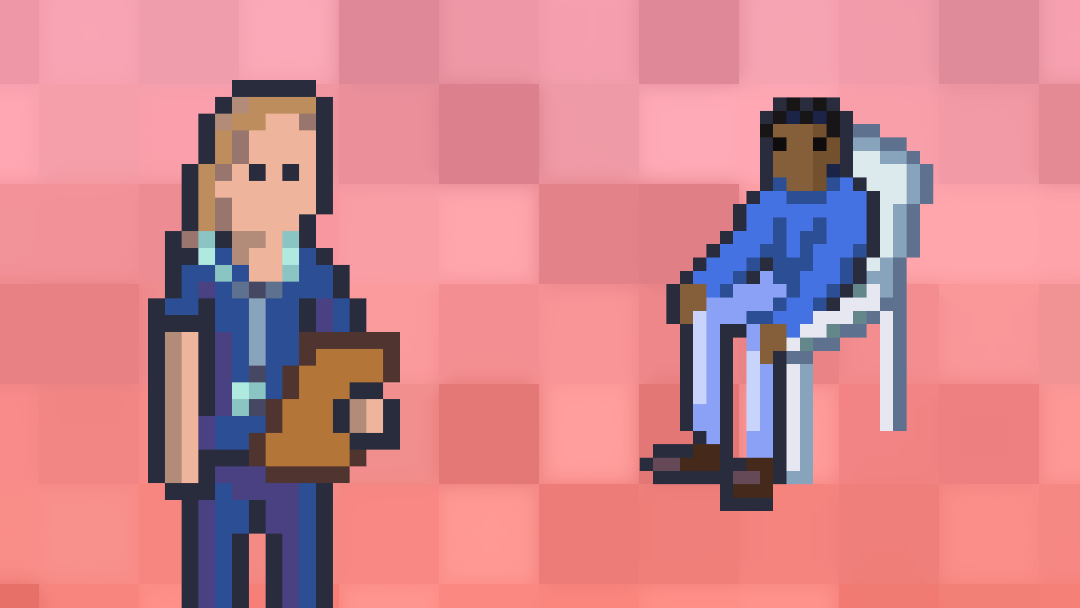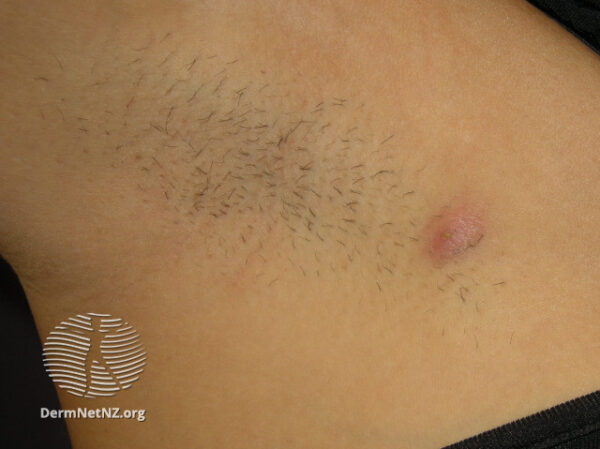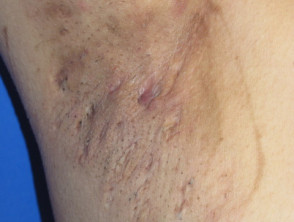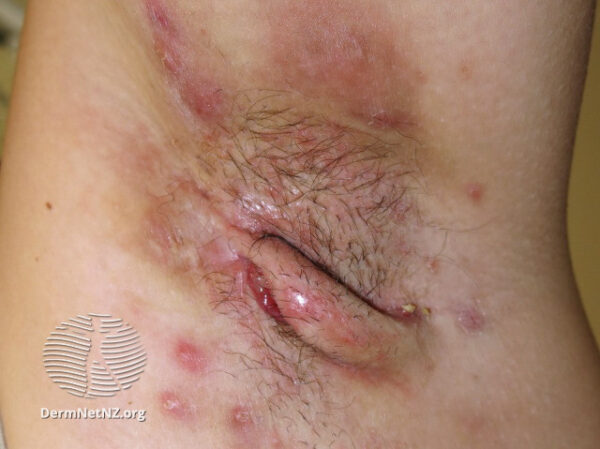- 📖 Geeky Medics OSCE Book
- ⚡ Geeky Medics Bundles
- ✨ 1300+ OSCE Stations
- ✅ OSCE Checklist PDF Booklet
- 🧠 UKMLA AKT Question Bank
- 💊 PSA Question Bank
- 💉 Clinical Skills App
- 🗂️ Flashcard Collections | OSCE, Medicine, Surgery, Anatomy
- 💬 SCA Cases for MRCGP
To be the first to know about our latest videos subscribe to our YouTube channel 🙌
Introduction
Hidradenitis suppurativa, also known as acne inversa, is a chronic inflammatory condition which affects the apocrine gland-bearing skin of the axillae, infra-mammary folds, buttocks and groin.1
It is caused by blocked hair follicles, which are connected to apocrine sweat glands, resulting in the formation of recurrent pus-filled abscesses and inflammatory nodules. Over time, this can result in sinus tract formation and scarring.1
Hidradenitis suppurativa often begins during puberty and is more common in females and people with skin of colour.1,2 Hidradenitis suppurativa affects roughly 1% of the population or one in 130 people in the UK.2,3
Aetiology
The exact pathogenesis of hidradenitis suppurativa is unknown; however, it is an auto-inflammatory process. Factors involved in the development of hidradenitis suppurative include:1
- Follicular occlusion
- An abnormal cutaneous microbiome
- Inflammation causing rupture of the follicular wall, destroying apocrine glands and ducts
Risk factors
Factors which are associated with an increased risk of developing hidradenitis suppurativa include:1,2
- Family history of hidradenitis suppurativa
- Obesity and insulin resistance
- Cigarette smoking
- African ethnicity
- Inflammatory bowel disease, in particular Crohn’s disease
- Acne
- Dissecting scalp cellulitis
Poor hygiene does not cause hidradenitis suppurativa.
Clinical features
History
Patients with hidradenitis suppurativa typically describe recurrent boil-like nodules and abscesses with purulent discharge in the axillae, inframammary fold, groin and inner thigh.
A single area or multiple areas can be affected. The nodules and abscesses can often become inflamed, resulting in tenderness and pain.
Patients can experience profound psychosocial impact due to this condition, with anxiety, depression and impairment of body image being commonly reported.1
Clinical examination
On examination of the skin, open double-headed comedones, tender inflammatory nodules, pustules, and abscesses can be seen.
Draining sinuses can develop, linking the inflammatory lesions. Hidradenitis suppurativa can also result in significant scar formation over time.1
The Hurley System describes three clinical stages of hidradenitis suppurativa based on severity.1
Table 1. The Hurley system
Differential diagnoses
The differential diagnosis for hidradenitis suppurativa includes:1
- Staphylococcal skin infections such as carbuncles
- Cutaneous/anogenital Crohn’s disease
- Cysts such as Bartholin’s cyst or epidermoid cyst
Investigations
Extensive investigations are rarely required. Bacterial swabs are usually negative, which is a clue to the diagnosis.1
If recurrent gastrointestinal symptoms are reported, patients should be referred for inflammatory bowel disease screening.7
Diagnosis
Hidradenitis suppurativa is a clinical diagnosis. The following triad must be met for a diagnosis to be made:1
- The presence of characteristic lesions (nodules, pustules, abscesses)
- In a typical distribution (i.e. axillae, inframammary fold, groin)
- Recurrent nature of the lesions
Management
General measures
There is no cure for hidradenitis suppurativa, but it can become inactive over time and with treatment.2
Patients with hidradenitis suppurativa should be screened for associated co-morbidities such as depression, anxiety, diabetes, hypertension, hyperlipidaemia and obesity.7
If patients are smoking, they should be encouraged to quit.1 If patients are obese, they should be encouraged to lose weight.2 Worsening prognosis occurs when there is a delay in diagnosis and management during the early disease stage.8
Topical therapies
Clindamycin 1% solution can be applied to the affected areas.7
Systemic therapies
Antibiotics
Initial treatment is with oral tetracycline antibiotics such as doxycycline for 12 weeks.7 In patients who are unresponsive to oral tetracycline antibiotics, combination treatment with oral clindamycin and rifampicin can be trialled.7
Other oral agents
In patients who are not responding to oral antibiotics, oral dapsone can be trialled.7 In males and non-fertile females who are unresponsive to oral antibiotics, oral acitretin, a vitamin A derivative, can be used.7
Biologics
The TNF alpha-inhibitor, adalimumab, can be used in patients with moderate-severe hidradenitis suppurativa who are unresponsive to conventional systemic therapy.7
Other management options
Intralesional corticosteroid injections can be used in the acute phase in carefully selected patients.7
Surgical excision can be considered in certain individuals with localised disease or where conventional systemic therapies have failed to minimise the recurrence rate.7
Complications
Complications of hidradenitis suppurativa include:1,7
- Superimposed infection
- Psychological impacts such as anxiety, depression, poor self-image,
- Genital lymphedema
- Inflammatory arthritis
- Cutaneous squamous cell carcinoma
- Anaemia
Key points
- Hidradenitis suppurativa is a chronic auto-inflammatory disease of the skin resulting in the formation of recurrent inflammatory nodules and abscesses
- It affects apocrine sweat gland-containing areas of the skin such as the axillae, inframammary folds, groin and buttocks
- Risk factors for the development of hidradenitis suppurativa include positive family history, obesity, insulin resistance, cigarette smoking and inflammatory bowel disease
- Symptoms of hidradenitis suppurativa include tender inflammatory nodules and abscesses with pus formation, malodour, pain and psychosexual distress
- Clinical findings include inflammatory nodules and abscesses in apocrine sweat gland-bearing areas of the skin. Double comedones, sinus tract formation and scarring are more common with moderate-severe hidradenitis suppurativa
- Hidradenitis suppurativa is a clinical diagnosis
- Management includes topical and oral antibiotics, intra-lesional steroids, surgery and systemic therapies including biologics
- Lifestyle modifications, including smoking cessation and weight management, should be strongly encouraged
- Complications of hidradenitis suppurativa include superimposed infection, scarring, psychosexual distress, anaemia and cutaneous squamous cell carcinoma
Reviewer
Dr Myranda Attard
Dermatology Specialist Registrar
Belfast Health and Social Care Trust
Editor
Dr Chris Jefferies
References
- Dermnet NZ. Hidradenitis Suppurativa. Published 1997, updated 2015. Available from: [LINK]
- British Association of Dermatologists. Hidradenitis Suppurativa. Published 2021. Available from: [LINK]
- Ingram et al., British Journal of Dermatology. Population-based Clinical Practice Research Datalink study using algorithm modelling to identify the true burden of hidradenitis suppurativa. Published 2018.
- Dermnet NZ. Hurley stage 1 hidradenitis suppurativa. Licence: [CC BY-NC-ND]
- Dermnet NZ. Hurley stage 2 hidradenitis suppurativa. Licence: [CC BY-NC-ND]
- Dermnet NZ. Hurley stage 3 hidradenitis suppurativa. Licence: [CC BY-NC-ND]
- British Association of Dermatologists. British Association of Dermatologists guidelines for the management of hidradenitis suppurativa (acne inversa) 2018. Published 2018. Available from: [LINK]
- Matusiak Ł. British Journal of Dermatology. Profound consequences of hidradenitis suppurativa: a review. Published 2020.







